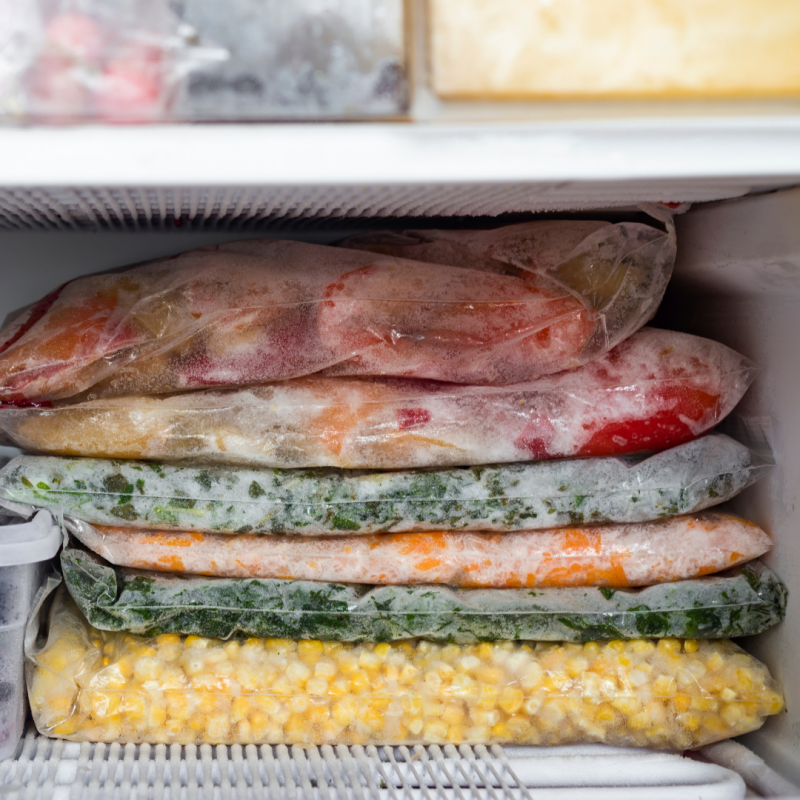Out of all the electrical items that can be found in our homes, the fridge is probably the one we deem least complicated to master, unfortunately though not all of us use it to the best of our advantage.
Why is it important to know how to store items?
Learning how to store food correctly and safely in our freezers or refrigerators is not only an important step in minimizing food wastage, but it will also ultimately help you save money and benefit the plant by stopping perfectly good resources from going to waste.
By organizing food items properly you’ll always be aware of exactly what you have, meaning that you won’t mistakenly buy something twice, or unintentionally let something rot or go bad.
Freezer
First items that come to mind when talking about groceries that can go straight into the freezer are ice and ice cream, then comes butter, meat, fish, pre-packed vegetables, and leftovers (find out more about the Environmental hazards of throwing leftovers down the drain here).
Other things which you can store in the freezer, and which maybe you didn’t know about, are flour, bread, ginger, garlic, cooked rice and pasta, eggs without shells, fruit and vegetables such as apples, bananas, tomatoes, avocados, celery, and even nuts.

Freezing all these items when you find yourself having large amounts and knowing you won’t be able to eat or cook them before they start going bad or turning rancid, is a great way to cut down on waste., the important thing is that they are stored away correctly, so pack everything in nice and tightly (optimize storage and save energy) and label everything with name and date so that you can recognize everything at a later time.
Door/doors
When thinking about our fridge door and what we store in it, most of us will immediately think of eggs and that that is the right place for them to be…unfortunately that would be a mistake!
In fact, although most fridges have a dozen little egg shaped holders in their door, it’s actually not the best option if we want our eggs to last longer.
As the warmest part of the fridge (since it’s constantly being opened and closed), our fridge door should be home to foods that are more resistant to spoiling. For example, we should use it to for condiments, juices, and other foods that can withstand continuous temperature fluctuations.

If you like trying new recipes often and have a tendency to always buy new dressings, sauces, mustards etc, make sure you group them by type (dressings all together, hot sauces all together, bbq sauces all together etc) so that you always have them under control and avoid buying duplicates.
Shelves
It may not seem like it, or maybe you’ve never really paid much attention to it, but just like the door, all the shelves in our fridge are different temperatures: Upper shelf temperatures are more consistent, and lower shelves are the coldest.
Pre-cooked items as well as foods that don't need to be cooked at all, such as drinks, dips, condiments, pickles (jars in general), leftovers and ready to eat foods, will all do better and last longer if placed on the top shelf.
Fresh herbs like cilantro and parsley can also be stored on top shelves, but in order to do so, remove them from the bags or containers they come in, and stick them in jars filled with a little water. This can sustain the herbs for a few weeks longer than normal.
All foods that are uncooked and that can spoil quickly, such as eggs, milk, cheese (wrapped in waxed paper or parchment - plastic wrapping will only absorb flavors and chemicals), meat and seafood, should be stored on the lower shelves, where the temperatures will always be lower.
Please note that raw meat holds high risk of bacteria if cross contaminated with other items, so be sure to dedicate a certain area of your fridge just to that by setting aside a locker or a bin just for that.

Crisper Drawers
Crisper drawer are designed to extends the life of fresh produce by controlling the airflow around them via the vents. Since most fridges come with two individual drawers it’s best to separate fruit and vegetables by dedicating a drawer each, since many fruits have the tendency to over-ripen when they come into contact with vegetables.
When storing produce it’s important to remember to take them out of the bag or container they are purchased in and wrapping herbs or leafy greens in damp paper towels, to make them last longer.

Our Multipurpose Muslin Bags with Drawstrings come in 4 different sizes.
(Click on the image to go to our store)
What else can you do to avoid food waste?
An important thing to remember when adding something new to our fridge is the FIFO method, or simply ‘First In, First Out’ . What this means is that it’s important to rotate the older items on the door, on the shelf or in the drawer, to the front, so that we’re always using what is older and what is most at risk of going bad.
Other ways to avoid throwing perfectly good food in the trash is to shop smarter. Once your fridge is in order, make sure your cupboards are too: By always having everything under control and making lists of what you need, you’ll be sure to not buy unnecessary items or larger quantities than need.
Another way to tackle food waste is to get creative with leftovers and invent brand new recipes every time!
Finally, start reading labels and find out the difference between ‘Sell by', 'Best Before' and 'Use by'.
Related articles:
